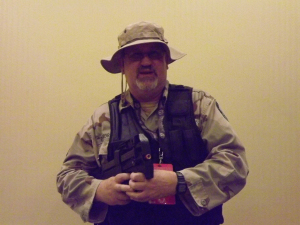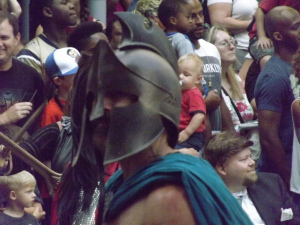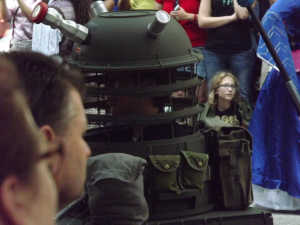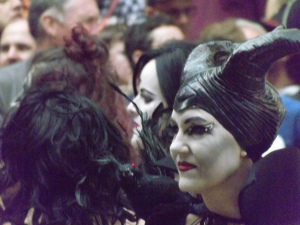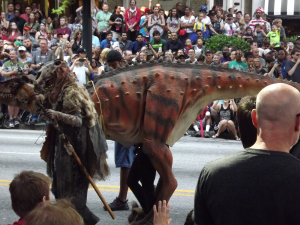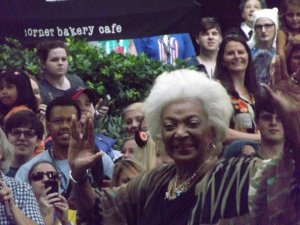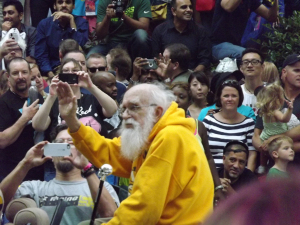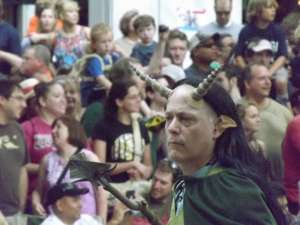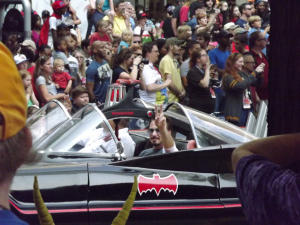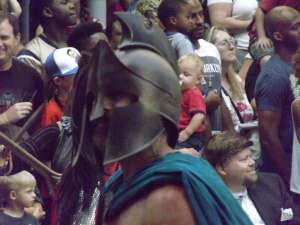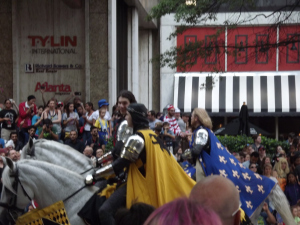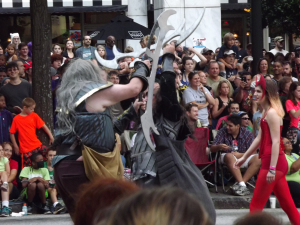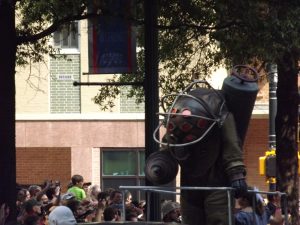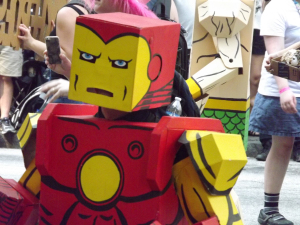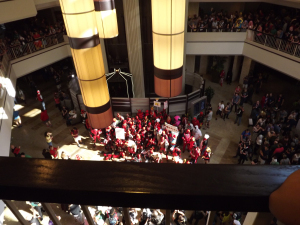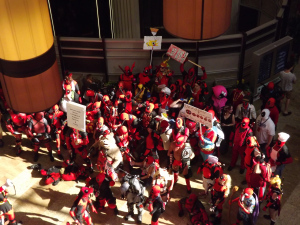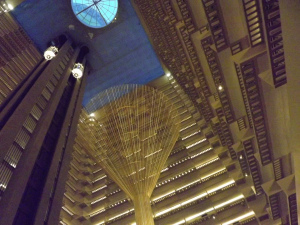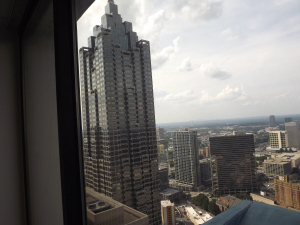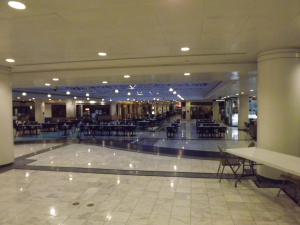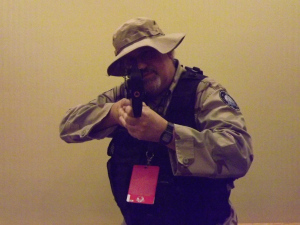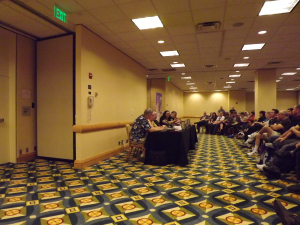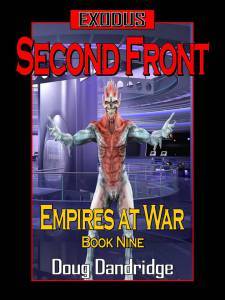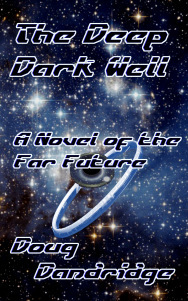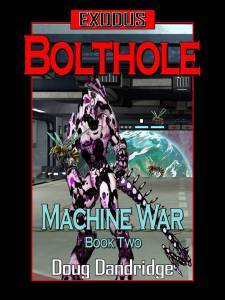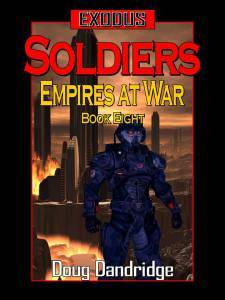Doug Dandridge's Blog, page 11
September 17, 2015
Dragon Con 2015: I Came, I Saw, I Got The T-shirt: Part 3
I was up early Sunday morning for a gathering of friends. I put on my Stargate SG-3 uniform, which was almost the same as my SG-1 costume except for the Marine theme, but left behind the vest and submachine gun. Cosplay is great, and I really admire the people who go all out the entire Con, but it can really be a hassle. So it was garrison costume for me, and since I was the colonel, my word was law.
Kevin J. Anderson holds a Sunday breakfast for the alumni of his Superstars Writing Seminar. I knew most of the people at the table, including Kevin and his lovely wife, Rebecca Moesta, as well as some other up and comers from the seminar. Short plug here: if you are at the point of your career where you want to learn the business of writing, the Superstars Writing Seminar is a good place to learn. Kevin, Rebecca, Eric Flint, David Farland and James Artemis Owen as regular instructors, with the addition of several guests every year. Enough for the advertisement, but I truly believe this is a good investment. The lobby of the Marriot was dead, a sign of the drunken debauchery that had taken place the night before, and with no parade to force people to get up too early, it was actually easy to get around. Anyway, good start to the day and I headed off to the first panel.
It seemed that Sundays were a little bit of a slowdown day in the past two Dragon Cons I had attended. As more people woke, like zombies leaving the dark, it got more and more crowded. By early afternoon it was again packed with people. The really popular panels and presentations again had long lines, the longest I had ever seen on a Sunday. And again, I was headed for the literature track panels that almost always had some room. Not as much as they had the first year I had attended, but there were always a few seats available. The first panel I went to was Agents and Editors Spill Their Guts. At the end of the panel I made contact with one of the editors who asked for my card, always a good thing. It’s always good to have someone at a publishing house know your name, especially if you want to move from a purely independent career to one of a hybrid.
I really didn’t have a panel planned next, but the Starship Smackdown, run by my friend Van Allen Plexico, looked interesting. I settled into the audience while the panel prepared. Van introduced the judges, James Palmer, who I had met the year before, and Scott McGlasson, who is the moderator of the Space Opera page on Facebook. Van said they would have three judges, and I wondered who the last one would be, when Van announced that he was going to ask someone from the audience to be one of the judges. And that was how I found myself on my first Dragon Con panel. Now I had been trying to get on a panel at Dragon Con since the year before, without luck. And here I was, on a panel having the time of my life. Thanks Van. The room was packed with an enthusiastic audience, so what more could I ask.
Starship Smackdown had the audience suggest sixteen spaceships from literature, video and games. Two out of three judges had to have heard of it, and some of the game suggested ships were too obscure for any of us to recognize them. We finally came up with our sixteen ships, including vessels from Star Trek, Star Wars, Babylon Five, Battlestar Galactica and Honor Harrington. We worked through the ships battling each other, and ended up with a combined Shadow/Borg ship (the Borg had assimilated the Shadow vessel to form the Shadow/Borg Chicken Cube) versus the Dauntless Superdreadnaught from Honor Harrington. After a little discussion, the judges decided unanimously that the Shadow/Borg would be able to appear right next to the Dauntless and take it. Great panel, and hopefully the first of many going on into future at Dragon Con.
Next up was Monsters and Mayhem, another Panel I wanted to attend so I could pick the minds of some editors. And what did I learn? Zombies are so last year. Wow. And here I was working on a fantasy novel for traditional submission that had zombies. Not as the most central feature of the novel, but still. Now they’re going to take an even lesser role in the novel.
After a meal break, I went to the SFWA meeting. I wasn’t sure what the meeting was going to be like, but like most meetings half of it dealt with things that really didn’t concern me. But again I made some contacts, one of which might really pay off in the near future. That’s part of going to a convention as a professional author. Sure, it’s fun, there are the same sights and sounds, the same fun to be had. But it’s also work, one of the reasons it’s a legitimate tax write off. Authors go to Cons to catch up with the latest things coming, the next big thing on the horizon, making new fans, learning new skills. And to make contacts. Some day I may need to send something to some editor, and knowing a little bit about them, their likes and dislikes, is always an advantage.
I finished off the day watching some bestselling fantasy authors, including Nancy Springer, who currently lives in my area of Florida, construct a round robin fantasy story. Then on to the Self Editing panel, which had some opinions I really didn’t agree with, and then the Getting Your Novel Turned Into A Movie panel, the last of the night. Fans sometimes ask me about when my Exodus series will get turned into a movie or movies. And honestly, if it took so many years before there was series talk of David Weber’s series getting onto the screen, it’s going to be even more before mine makes it.
Next up: Dragon Con 2015: I Came, I Saw, I Got The T-shirt: Monday and Final Thoughts.
Filed under: Conferences, Dragons, eBooks, Fantasy, Future Prediciton, Kindle, Magic, science Fiction, self publishing, Writing Tagged: David Weber, dragon con, James Palmer, Kevin J Anderson, Nancy Springer, Rebecca Moesta, Scott McGlasson, Superstars Writing Seminar, van allen plexico


September 11, 2015
Dragon Con 2015: I Came, I Saw, I Got The T-shirt: Part 2.
So Saturday dawns, the official second day of the Con, and really the showcase. This is the day that features the largest crowd, the longest lines, and waiting. The day passes are in evidence this day, the one day attendees crowding the hotels. And it is the day of the Parade.
This year the Parade had forty-seven groups entered. A group could be something like the Battlestar Galactica cosplayers, or Starwars, or Superheroes. They had a Game of Thrones group this year, and a Box Superhero group. Missing this year was the company of Iron-men, while Deadpool seemed to be this year’s favorite character. The Guests of Honor rode in the parade in cars, and included Ms. Nichelle Nichols (Uhura from Star Trek), James Randi (The Amazing Randi, famous debunker), and Peter Hamilton (author). It didn’t start until ten, which made me miss the early panel I wanted to get to. Still, I’m amazed they were able to get that many people up from partying Friday to get in their costumes and walk the route. They changed the route this year so more people could view the parade, at the request of the City of Atlanta. The new route included several parking garages, allowing people to fill up the levels to see the parade. From what I heard, that was hell on some of the cars that had people climbing all over them. To me, the coolest thing about the Parade is seeing all of the imaginative costumes. Some were very simple, some complicated, some cheap, some expensive, and some very labor intensive. Working wings, Iron-man and Robocop suits, costumes from famous and obscure series.
I left the Parade early because I wanted to make an 11:30 AM panel and didn’t want the lines to stop me. Here’s where I get to mention Dragon Con TV. In past years, when I had stayed in offsite hotels, I had only seen Dragon Con TV when attending panels that had wall mounted screens. They showed very funny, imaginative and silly skits based on popular TV and movies. This year, staying in one of the host hotels, I was able to watch Dragon Con TV in the morning and before going to bed. More skits, funny commercials, and replays of the big events. Saturday night I was able to watch the rest of the Parade with comments. At the 11:30 panel I wanted to get a book signed by Larry Correia. He was in a hurry, but still found the time to scribble a signature in my copy of Hard Magic.
After two panels I was ready to head to the Market, where all the venders are set up. I really enjoy my time going through the hundreds of tables, looking for a book, or even more important, a signed book. Or some nick nack that just catches the eye. This year the line was stretching around two blocks, and I just had to give up on that. Dragon Con needs more vender space, and a shorter wait to get into it. I‘m not really sure how they’re going to handle that, so I’m guessing the space is just going to get more and more crowded. After the first year I have made it a point to stick with the Science Fiction and Fantasy Literature and Writers tracks, which feature many of the guests I want to see, authors and editors, and are the most likely to help my career moving forward. Not to say I won’t go to some of the other tracks, but if I do, I try to get there very early, as the lines can be unreal. Atlanta was cooler than usual this year, so there wasn’t the intense summer heat to deal with, but standing in line for an hour, only to be turned away at the entrance to the event, is not one of my favorite things. And this year the lines seemed to be longer than ever.
I attended one space panels given by my friend, NASA Scientist Les Johnson, about solar sails. Les is both a science fiction writer and a hard core scientist. He is working on solar sail missions at this time, and his enthusiasm is catching. Les had encouraged me to attend the Mars panels on Sunday, but after that panel I saw how that would go. The room was packed, and as soon as the old crowd filed out at the end of the presentation, is was repacked with an entirely new crowd that had been waiting outside. So I was back to the Embassy rooms for most of the rest of the day. There was one really cool incident when coming out of the Space Track presentation. There was a large group of Deadpools gathered in the Hilton Lobby. Singing, dancing, chanting. There were traditional Deadpools, Deadpool variations, male and female, and shapes and sized. Only to be seen at Dragon Con.
I worked my way over to the Westin for one panel, the Alternate Warfare talk with Eric Flint, Jack Campbell and Taylor Anderson, among others. I talked with a young guy in the Navy while waiting for the doors to open. He was a scifi fan, and I talked to him about my own books and passed on one of my cards. An older gentleman and his wife came over and sat next to us, having heard our talk, and they received cards as well. If you are a writer, you need to carry cards with your author page, website, email and other contact information. I was low on cards for this Dragon Con, but still stretched them out until Monday morning. After that it was back to the Hyatt for one more panel, then the fight through the crush between hotels to get to the Marriott elevator bank.
I settled down in my room to do some writing, and watched the Costume Contest on TV. Again, there were some very imaginative costumes, and some that were very simple. I didn’t agree with any of the winners, but that was just me.
Up Next: Part 3.
Filed under: Alien Life, Armor, eBooks, Fantasy, Far Future, Future Prediciton, Future Warfare, Intelligent Life, Kindle, Magic, Military, Proofreading, Space Industry, Space Navy, Tropes, Writing Tagged: dragon con, Jack Campbell, James Randi, Larry Correia, Nichelle Nichols, Taylor Anderson


September 9, 2015
Dragon Con 2015: I Came, I Saw, I Got The T-shirt: Part 1.
Well, Dragon Con 2015 is in the books. Saw everything I could see, did everything I could do, and today I feel like I have risen as an unthinking zombie. Dragon Con seemed to be bigger this year, especially on Sunday. Sunday last year it was obvious that people were leaving. This year, Sunday seemed just as crowded as Saturday, and even the Monday morning events were well attended. I’ve only been going to Dragon for the last three years, and have learned a little more of the history of it every year. Like this year I found out that this massive undertaking started out with four hundred attendees, and that there had been talk about capping it at twenty-thousand one year. And now it has to have reached eighty thousand including Saturday day passes. I learned that this Con was different from any of the other megacons across the country in that it was hosted in the hotels, and not a convention center. Dragon has five host hotels, with the Marriot right in the center, flanked to either side by the Hilton and the Hyatt, with the Weston and Sheraton hotels just down the street in opposite directions. The Marriot, Hilton and Hyatt are all connected by enclosed sky bridges, and the Marriot and Hyatt have sky bridge connections to the food court at Peachtree Plaza. From what was said at the Con, every other large convention in the country has its panels and performances in a convention center, away from the hotels. And I learned that the con scheduled popular events against each other on purpose, forcing the attendees to choose so that one panel is not overloaded. And man, were there a lot of panels and a lot of tracks. I spent most of my time around the Writer’s, Scifi Literature and Fantasy Literature tracks, with a couple of forays into Alternate History and Space. But they had tracks for Science, Skepticism, Paranormal, Battlestar Galactica, Star Trek, Gaming, Comics, Movies, and many more.
This year I was able to get into Marriot Marquis thanks to a writing friend who could not attend this year. I arrived at about 4:20 PM, twenty minutes after the start of check-in for that day, got the valet parking so I wouldn’t have to worry about the car, and waited about ten minutes to get checked in. My room was on the forty-fourth floor, and riding the high speed glass enclosed elevator up to my floor was like an amusement park ride. The view of the city was spectacular, and I saw the stadium for Georgia Tech nearby. There would be a game played there on Thursday, and that Wednesday the stadium was lit up to test the lighting system. The Peachtree Plaza food court was open, so I had some pizza and walked the Marriot lobby for about a half hour. There were already plenty of people gathered there in small parties of ten to thirty, making or a crowd of several hundred. Surprisingly, my room was very quiet, and I did not have any noise coming through to disturb my sleep.
Thursday was registration day, and it took very little time, less than five minutes, to get my badge at the Sheraton. It was a longer wait for a T-shirt, about fifteen minutes. I spent the rest of the day in my room writing, and discovered that I had accidently erased a chapter or so from a work in progress. Not fun. I then joined my friend Richard Laudenslager for a small party amongst the larger gathering in the Hyatt Lobby. Now things were starting to get going, with several hundred people in all the hotel lobbies getting the party going. There were already costumes in evidence, and everyone seemed to be having a good time. I had dinner with Richard afterwards, and we talked comics and writing for about an hour before I headed back to my hotel and more writing.
Friday was the start of the main event. The hotels were now swarming with people, costumes were out en-mass, and the party was truly on. I started my day, in my SG-1 costume, at the first of two workshops I took with Michael Stackpole. Unfortunately, my P90 sub-machine gun broke early in the day. One of the few mishaps I had during the entire weekend. The big event of the day was the presentation by Chuck Gannon about how he plotted the future of his Caine Riordan series. At that presentation I met a fan of mine, J Alfred Goodwin, who was also a Gannon fan. I also met Jack Campbell at the next panel and got a book signed. At 8:30 PM I went to a very small get together at Chuck’s room and met some other authors and an editor of a short story magazine. All together a very productive day, and I headed back to my room exhausted. Now I can’t drink. Not that I don’t drink, but I really can’t, and I wanted to make panels, but for those who like to indulge, the party goes on late into the night, and the two lobbies I had to navigate took about five to ten minutes each to get across. Now came the elevator waits which everyone complained about. If you were on the upper lobby the elevator was already full before it came back to your level. The trick was to get on the elevator on the way down to the lowest lobby level so you would have a space. On one trip there were too many people on the elevator and it refused to move.
And so ended the preliminaries and first day of Dragon Con 2015.
Next Up: Dragon Con 2015: I Came, I Saw, I Got The T-shirt: Part 2.
Filed under: Armor, Comics, eBooks, Fantasy, Far Future, Future Prediciton, Kindle, Magic, Marvel, Military, Nanotechnology, science Fiction, self publishing, Writing Tagged: Chuck Gannon, dragon con, Jack Campbell, Stargate SG-1


September 1, 2015
My Best Month Ever?
September of 2012 was the first month I ever gained any traction on Amazon, the giveaway of the Deep Dark Well to the tune of 4,035 attracting the attention that started the sales rolling. That month I sold 237 books. In October, 2012 it was 538 books, then 1,558 in November and 4,615 that December. January of 2013 was truly a monster month, with 8,560 eBooks going out. That was my biggest month ever by volume, but I was selling most of my books for $2.99 at that time, so the profit was not as large per unit as it has grown to. Still, I made over $16,000 that month, and decided then and there that my days at the State of Florida were numbered. I left the state in March of 2013 and have never looked back. In June of 2013 sold 6,998 books, in January of 2014 6,190, while May of 2014 saw my first $20,000+ month with 7,002 sales. Not every month has been that good, of course. In February of this year I sold a low of books since that breakout November of 2012, 1,210 units. None of these figures include audiobooks, of which I have sold about 3,200 to date, and paperbacks, which have sold about 1,300.
August of 2015 sales totals were 6,045 eBooks and 51 paperbacks. Again, this does not include audiobooks. Now this is not a record month for unit sales, and in fact has been beat by four other months. But it exceeded May of 2014 in revenue. I will not really know how much until the payments come in at the end of October, but I am confident it will be by a good margin. This month also saw my first sale to Mexico, and well as record sales to Germany and France. Germany is tied with Canada on an alternating basis for my third largest market, after the US and UK. France is my sixth largest market, which really isn’t saying much, though I really appreciate that small cadre of diehard fans in that country. Australia is number five, and they were a little better than their average this month, while I had no sales at Amazon Japan or Netherlands.
I also had 338,110 page views for my books that are on Kindle Select, meaning people can borrow them through the Kindle Owner’s Lending Library and Kindle Unlimited. My books average about 360 Kindle pages, including matter at the back, and run between 100-130K words. That came out to the equivalent of 939 books, and under this new scheme I am making more per book in this program than I was when they were paying the same for a twenty page short read as they were for a novel. Not as good for those short story writers who could attract readers, but much better for us novelists.
So, is the point of this post to brag about how well I’m doing. Maybe a little. I am human, I made the dream work, and I feel like crowing it from the rooftops. More importantly though, I am living the dream, have made a successful career without the aid of a publisher, and am an example to others of how it can be done. I am by no means the most successful indie published science fiction or fantasy writer out there. I personally know of three others, Hugh Howie, Chris Nuttall, and Evan Currie. I still need to figure out what they have done to promote themselves. And I am sure there are others out there just as successful that I haven’t heard of, yet.
Exodus: Empires at War: Book 9: Second Front was the driving force of the success of last month, selling 4,131 eBooks and probably 20 paperbacks. It also garnered 49 reviews in the US (thirty-nine 5*, eight 4* and a single 3*) and 12 in the UK (eleven 5* and one 3*, and the three star’s complaint was that the series was too long. So I guess he will continue to be disappointed in the future, because it’s going to get longer. Currently I am working on Exodus: Machine Wars: Book 2: Bolthole, and have 71,000 words down so far. DragonCon is coming up, and I am planning on doing a little bit of work on something or other while I am there. Of course that may not happen, because, well, DragonCon.
I want to finish by thanking all of the people who enjoy my books and especially those who leave reviews. I realize I am not the best writer in the world, and I am grateful that you enjoy my sometimes overly complicated plot lines and long battle scenes. Thanks for making my dream possible.
Filed under: eBooks, Fantasy, Far Future, Kindle, Military, Movies, Plotting, science Fiction, self publishing, Writing Tagged: Chris Nuttall, Evan Currie, Hugh Howie, Kindle Owner's Lending Library, Kindle Select


August 24, 2015
The Deep Dark Well hits 6K
Something kind of cool happened this last week. One of my eBooks recorded its six thousandth sale. The Deep Dark Well was the first eBook I put up on Amazon. It garnered my first review, a three star (due to formatting problems) that was later raised to a five star when said problems were corrected. That and several other good reviews helped me to get over the initial fear of putting more stuff up. Still, it probably sold twenty copies in its first eight months. Not really ground breaking. It was also my first giveaway on Amazon, 4,100 copies going in five days, and kick started the whole Exodus: Empires at War series, released two months later. Still not my most successful book. Seven of the nine Exodus books have outsold it, some by large margins. Book 1 has sold over 23,000 copies, while three other books have gone over 10,000, with one more surely due to break that mark before the end of the year. All this in a total of over 140K books in thirty-six months.
So what’s the big deal about this one book? The Deep Dark Well was the first far future book I ever wrote. It’s the story of a redheaded Kuiper Belt miner from Alabama, Pandora Latham, who escaped her domineering and abusive father by going into space and fueling the terraforming of the inner Solar System. When her ship encounters a passenger vessel from the future, she leaps into a wormhole to escape the paradox destroying reaction of the Universe, and finds herself on an enormous station built around a black hole, forty thousand years in the future. This was my first big concept novel as well, a tribute to people like Larry Niven and Poul Anderson. It was also the first novel to garner not one, but two long personal rejections that gave me some hope I could actually do this writing thing.
So, again, what’s the big deal about this book selling 6K, when I have so many others that have done better. It validates one of the main concepts of the Self-publishing Revolution. You don’t have to sell all your eggs at the one day market. What I have learned in several workshops is that, according to the old traditional model, you had to sell or die, quickly. Under the traditional model there was a five thousand book run for most new authors. The books went to the bookstores, and the clock started ticking. Those that didn’t sell in a certain time span were sent back to the publisher. Now an eBook, which really doesn’t take up any shelf space, can sit in the electronic bookstore forever, selling fifty copies this month, twenty the next, on and on. As Hugh Howie said during a panel at DragonCon 2014, you don’t have to sell all of your books at one time. You can sell as many as a traditionally published book has to sell in a couple of weeks over a period of years and still consider it a successful property. The Deep Dark Well has sold thirty copies so far this month, about average for the last two years. I expect it will continue selling about that much each month for years to come. Not a great deal of revenue each month, but over time? It all adds up.
When I wrote The Deep Dark Well, I considered it my finest effort to date, and I’m sure it was. I have written so many more books since then, some much better that TDDW. Practice may never make perfect, but it normally results in improvement. It still holds a place in my heart as the book that started my self publishing career. And, as I learned from Dean Wesley Smith and Kristine Kathryn Rusch, as a professional author, every little trickle of revenue helps to feed the rushing stream of your total income. So today I celebrate the slow, quiet success of this novel which started the whole writing career going.
Filed under: eBooks, Fantasy, Far Future, science Fiction, self publishing, Writing Tagged: Dean Wesley Smith, Hugh Howie, Kristine Kathryn Rusch, The Deep Dark Well


August 3, 2015
Exodus: Empires at War: Book 9: Second Front, Has Arrived.
Exodus: Empires at War: Book 9: Second Front is now out on Amazon all over the world. To get it in the US go to Amazon at this Link. In the UK go to this Link. It has already sold over a 150 copies in the first twenty-four hours, and looks to be a big success, as were all the prior books in the series. The paperback will be uploaded to Createspace in a couple of days, and should pass their review process several days after. Look for it in the Createspace store right after that, and on Amazon a week or so later. I immediately started work on the next book in the Machine War offshoot series, Bolthole, with already had about 15,000 words written. I hope to have that finished before I go to Dragon Con. If not, then soon after. And then I will be concentrated on a couple of months to write a fantasy submission to Baen, followed by book 10 of the main series. That’s it for this post, as I have a lot of things to do to get that next book out on time.
Filed under: Alien Invasion, Alien Life, eBooks, Far Future, Genetic Engineering, Military, Nanotechnology, Quantum Physics, science Fiction, self publishing, Titles, Tropes, Wormholes, Writing Tagged: Exodus: Empires at War, Exodus: Empires at War: Book 9


July 31, 2015
Exodus Nine Is On The Way.
Exodus: Empires at War: Book 9: Second Front will be coming out in a couple of days. As the title says, this book is about the war going on at the other front of the Ca’cadasan Empire. A human expedition of three specialized ships have been sent across the more than thirty thousand light years, a year’s travel at hyper VII. The Empire is looking for another ally, and what better prospect than one who was already at war with their mutual enemy. They finally get there, and find that what they were hoping would be friends had a dark secret.
At the same time, the Ca’cadasan fleet that had been heading into New Moscow in Book 8 has arrived, and the Empire has another fight on its hands. The Empire turns to unlikely allies to defeat their foes, and try to forge a far alliance despite the problems.
This book has more politics and intrigue than most in the series, but still has plenty of action, both ground and space, with the emphasis on the space. Next up will be Exodus Machine Wars: Book 2: Bolthole. And now for an excerpt.
“My, Lord,” said the bowing officer, his upper hands grasping the base of his horns while his lower arms crossed over his chest in an aspect of absolute obeisance.
Great Admiral the Superior Lord Jarrashinata Karzott glared down at the officer as if he were looking down on the vermin of his home world. While the male was giving the proper display of respect to one of his stature, with the double advantage of supreme military and civil rank, being as he was a cousin to the Emperor, there was something about the aspect of the Cacada he did not like. More than just the general fear of a subordinate reporting to the exalted presence of his supreme commander. The fear of someone who was afraid that the news he was about to bring would cause him great pain, or even death.
“Out with it,” said the Great Admiral, who had taken command of the Front weeks before on the orders of the Emperor. “I do not punish messengers merely because of the news they bring.”
The male glanced up at the Great Admiral as if he wasn’t quite sure to make of the words. After all, the last commander was quick to punish anyone who brought news he didn’t want to hear. Which was why on occasions important facts were withheld from him.
“The Klavarta have taken the H’lada system, my Lord,” blurted out the male, as if giving the information quickly might mitigate the response.
“When?” growled the Great Admiral, thinking of what little he knew about that system. It was one of the linchpins of his defensive front, and a major staging area for launching forces into the flank of the enemy Empire. It contained shipyards, depots, even rest and recreation facilities for his forces. And it was fifty light years behind what he had assumed were the lines, safe from enemy attack. But now it seemed not safe enough.
“We just received word from the courier minutes ago, my Lord,” stammered the male. “It took that ship twenty-five days to get here.”
So, about fourteen hundred light years, thought the Great Admiral, looking away from the male and ordering the chamber holo to show him his command area with a thought. The Front stretched almost four thousand light years from rimward to coreward, and over two thousand from the top to the bottom of the galactic disc. Essentially, there was no way to blockade that much space. The only possible defense was to have scattered strong points, systems with heavy defenses and a strong fleet presence. And to patrol the regions in between.
“How did we lose that system?”
“From the records the courier brought, my Lord, the same way they have taken all of the other systems they have assaulted. With overwhelming numbers.”
The Great Admiral turned and stomped away, trying to calm himself down before he actually hurt the messenger, something he didn’t want to do, lest others be afraid to give him information he was sure not to like.
They are like vermin, he thought of the Klavarta. They reproduced at an unbelievable rate, and unlike most vermin they carried a fearsome sting.
How in the hell did we get ourselves in such a situation, thought the Great Admiral, plopping down in his chair and gesturing for the messenger to leave, then motioned for one of his serving slaves, a moderate sized radially symmetrical mammalian, to bring him a drink. He ran over the situation in his mind, recalling the reports he had read, the videos he had watched.
The Empire had been expanding in this direction, down the Sagittarian arm, as they always had, overrunning other civilizations with a battle or two, then taking them into the Empire. When they met another expanding species, always still in the early stages of their growth as a power, it took some more battles, but in no instance had the fight lasted longer than two or three years. The Ca’cadasan Empire was fulfilling its destiny, and it looked like in two or three thousand more years of steady expansion they would truly rule the entire Galaxy, just as the Gods intended.
And then they had hit the border of the Klavarta, as they called themselves. There was still debate as to whether there were other species in their Empire, which stretched two thousand light years along the Sagittarian and Perseus arms. So far no others had been found, though there was some intelligence that another species actually ruled their Empire, hints gleaned from captives who were otherwise noncompliant to any known interrogation technique.
The unusual thing about that border region, for two hundred light years up to the first Klavartan outpost, was their complete and total lack of intelligent life. One billion two hundred million cubic light years of emptiness as far as intelligence was concerned, an area of several hundred million stars. There were worlds with life, the same number as most regions the Ca’cadasans had already conquered. And there were ruins, everything from stone age encampments to supercities, all burned out. And skeletons, for those sophonts who possessed bony skeletal framework.
The word had spread through the Ca’cadasan Empire and military. A terrible word. Genocide. The Cacada had totally wiped out three intelligent species in the history of the Empire. Really only two if truth be told. One was the communal mind creatures who had actually invaded and conquered the homeworld prior to the Empire. They had been sought out and destroyed in revenge for what they did to the people. The other was an advanced civilization that had stayed in their own system. That species had refused to surrender, and destroyed everything that tried to land on their planet. So the Cacada had been forced to bombard them with missiles moving at near relativistic speeds. Too many missiles had gotten through, and reduced the planet to total lifelessness, along with the intelligent beings that lived there.
The only other species the Empire had exterminated were the humans, only it was thought some might have gotten away, and a small population was kept to be able to spy on them if they were found again. And then they had found more humans on the other side of the Empire. So even in that instance the Race had not committed genocide, a crime against the Gods according to their religion. They could subjugate other species, hold them in slavery for the good of the Empire. But future genocide, except in the one limited proscribed case, that of the humans, was forbidden.
The imperative was changed with the discovery of those planets. It was no longer simply conquest and expansion. It was to find and punish the blasphemers who were destroying intelligent life. The Empire switched from slow expansion to a quick thrust by hundreds of small task groups into the Dead Zone, as it was called, looking for civilizations that might have survived, and for that which was killing off the intelligent species in the region.
Scores of those task forces found what they were looking for, at least the second part. Those task forces disappeared without a trace, followed by more of them in the coming weeks, and the Empire knew it had a real war on its hands.
Large groups, fleets of a thousand ships each, followed into the Zone, looking for an enemy, that now could not be found. It took a year of cautiously searching before the enemy struck again, and this time they attacked a force that was able to fight them off, at least enough to get away and warn the Empire what they faced.
What they faced was a species that seemed to have been constructed for war. A species made up of a number of subspecies that were specialized in their function, performing their assigned tasks better than any of the Cacada. They fought in small ships, a hundred thousand tons or smaller, faster, more maneuverable, and what they lost in firepower they more than made up for in numbers. There always seemed to be more of them, and they fought to the end. Every, single, time. Retreat and surrender did not seem to be in their vocabulary. The few who had been captured had been injured too badly to resist, in vessels no longer capable of operation.
For ten years the war raged on, without the Empire finding a single one of the Klavarta homeworlds, not even a base beyond some large stations orbiting gas giants in otherwise unimportant systems. Back and forth through the Dead Zone, until the Ca’cadasans finally broke into the space of the enemy Empire and encountered a Klavartan homeworld, or at least one that had a shitload of the aliens. After that it was ten years of back and forth into each other’s home territory. And then the last five years, when the Empire at first seemed to be winning the war, pushing back the enemy, until a massive enemy counter offensive pushed them back into their own space once again.
Filed under: Alien Invasion, Alien Life, Antimatter, Armor, eBooks, Future Warfare, Genetic Engineering, Genetics, Military, science Fiction, self publishing, Space Navy, Wormholes, Writing Tagged: Exodus, Exodus: Empires at War: Book 9, The Exodus series


June 30, 2015
Liberty Con 28: The Little Con That Could, Part 1
I just returned from Liberty Con in Chattanooga, Tennessee. Not a big event, it nonetheless has been around for a long time. Twenty-eight years to be exact. With an original organizer like Robert ‘Horseclans’ Adams and past GOH such as A E van Vogt. Not really a large Con, it’s hosted at the historic Chattanooga Choo Choo which has one convention building onsite, and is therefore limited to just over seven hundred attendees. Many of the attendees were authors, scientist sand artists who did presentations at the Con, and I would venture to say it probably has the largest ratio of attendees to presenters of just about any Con out there. The panels are first rate, with bestselling authors and NASA scientists headlining some of the presentations. And it’s never crowded. Even the most well attended panel has some seats for the late comer, and at its most crowded the common area is only a mild hassle to get through.
I’m relatively new to the Con scene. The first Con I ever attended was the very small Altcon in Tallahassee in 2013. I was a panelist at the next Altcon, and this year it looked like a convention that was trying to die. Dragon Con 2013 was my first big Con, and BIG is the word for it. Some rooms at Dragon could hold the entire attendance of Liberty, and for many of their panels people are turned away. In 2014 I attended five Cons, Altcon, the dying Liberty Con, the now defunct Alabama Phoenix Festival (which rose from the ashes, but the ashes pulled it back to nonexistence), Dragon once again, then the inaugural Honor Con in Raleigh, NC. This year it will be three, Altcon again, since it’s right in my hometown, Liberty and Dragon.
Liberty had quite a lineup. Most of the traditionally published authors are from Baen, or at least one of their series. David Weber was the Guest of Honor, and Eric Flint came to this one with an entourage of 1632 contributors. Also in attendance was back to back Nebula Nominee Dr. Charles Gannon, Jody Lynn Nye; her husband, editor and author Bill Fawcett; Les Johnson of NASA and a Baen author, John Ringo, David Drake, Sarah Hoyt, Campbell Award Nominee Jason Cordova, and many others. There were also a number of small press and indie authors, including best sellers such as Peter Grant and myself. There were artists and game developers as well. And Toni Weisskopf, the publisher of Baen books. Liberty is a great opportunity for networking. There are all these people there who are either more successful than you, or are up and comers. And there are plenty of opportunities to talk.
The science fiction writer community is actually kind of small, and it’s surprising how many people know how many other people, and I’ve learned in the few years I’ve been attending that opportunity knocks when you actively join that community. I’ve made some good contacts at Dragon Con as well, but Dragon is an enormous event, and sometimes it’s really hard to get the ear of the person you really want to talk with. It was much easier at Liberty. In fact, you might see that person in the restaurant for breakfast, or typing away in the main lobby, or the smaller entry of one of the two hotel buildings.
Liberty Con may be a hard ticket to get in the future. Most people who go come back, and there were some newcomers this year who are sure to join the ranks of the Liberty Con family. I signed up for next year before I left, I didn’t want to take the chance of missing it.
Up next time: the experience of sitting on a Con panel.
Filed under: Agents, Conferences, eBooks, Fantasy, Far Future, Military, Plotting, Writing Tagged: Bill Fawcett, Chuck Gannon, David Weber, dragon con, Eric Flint, Jason Cordova, Jody Lynn Nye, John Ringo, Les Johnson, Liberty Con, Michael Z Williamson


Soldiers – Absolutely great book in the Empires at War series.
Blog post from PG’s Ramblings about Exodus: Empires at War: Book 8.
 Originally posted on PG's Ramblings:
Originally posted on PG's Ramblings:
Soldiers (Exodus: Empires at War #8) by Doug Dandridge
My rating: 10 out of 10 stars
The Cacas have been kicked out of the Empire and Republic, but New Moscow is still at risk.
Less than a billion of the original fifty billion population are left, and they are being turned into rations for the Conquerors.
Sean and the Alliance Fleet have ejected the Ca’cadasans from the territory of the New Terran Empire and the New Terran Republic. But the deadly aliens remain in the space of the Kingdom of New Moscow. Centuries before the people of the Czar emigrated from Republic space, setting themselves up hundreds of light years from the borders of the two larger polities. They have paid for that mistake, the Cacas rolling over them and almost obliterating their population. Now the large aliens are processing the survivors of New Moscow to feed their…
View original 722 more words
Filed under: Uncategorized


May 14, 2015
Exodus: Empires at War: Book 8: Soldiers is Coming Part 2
I will be uploading Exodus: Empires at War: Book 8: Soldiers to Amazon before I go to bed tonight, which means it should be available worldwide sometime before the sun rises Eastern Time. I also approved the audiobook of Exodus: Empires at War: Book 3: Rising Storm, which should be available over Amazon and Audible in the next three or four days. As mentioned in the last post, Exodus 8 will have a combination of ground and space warfare. In fact, it’s almost a fifty-fifty split for the types of action. Samuel Baggett and Cornelius Walborski will again be the main POV characters for the ground action, with the addition of some new characters, while Bryce Suttler and Admiral Len Lenkowski will have roles in space, though other characters will also share the spotlight. I am already at work on Exodus 9: Second Front and have done about fifteen thousand words on Exodus: Machine War; Book 2: Bolthole. I also have the covers in hand for those books. This weekend I will format Exodus 8 for paperback, and it should be available through Amazon and the Createspace store by next week. I don’t sell that many paperbacks, but still do them as a courtesy to fans who prefer that kind of reading experience, or for the infrequent times I do book signings. So here’s an excerpt of the space action, showing that not everything always goes to plan.
One of the missiles that had made it through the close in defensive fire was kicked over by the blast particles and went spinning out of control. Three made it through intact, their sensors scanning for the targets they had been set to look for. Two located the same target, while the third couldn’t find what it was looking for and instead locked onto the largest vessel in the area, an eight million ton assault ship.
The lone missile that homed in on the attack ship almost made it through untouched. The assault ship, the Kharkov, picked up the missile at the last moment. The ship was not equipped for ship to ship offensive operations, but the defensive suite was comparable to that of a heavy cruiser. Short range lasers fired, while the missile juked and swerved, its jamming systems coming up to full power. Close in weapons took over, sending a wave of explosive shells toward the missile. One shell hit the missile body, shredding it, and the warhead followed suit. The weapon detonated five kilometers off the bow of the ship, sending its blast of radiation into that part of the vessel.
The ship shuddered from the breech of its lightly armored hull, and one of the forward hangars blew open, throwing orbit to atmospheric craft out into space, destroying a quarter of the ship’s complement of support craft. Kharkov limped on, trying to get into position to support the people on the surface while streaming atmosphere from multiple hull breaches.
The last two missiles came in on the same target, one of the stealth/attack ships with an attached gate. The ship was almost helpless, unable to bring its own defensive weapons to bear due to the portal being in the way. A battleship was in the process of transiting the gate, the fifteen million ton Queen Elizabeth III. Half of the ship was through, but it was still in no position to defend itself or the gate. Still, the forwardmost laser ring was able to get in a pair of shots. One hit a missile square on the nose from a hundred kilometer range, detonating the missile at a distance from which the radiation load was minimal. The second missile was hit by the stern, causing it to go into a tumble that caused it to detonate a kilometer from the gate.
The battleship would have handled that close a blast with little problem except for some surface damage. The gate itself was much more fragile, and the frame couldn’t handle that heat. Two hundred meters of the outer portion of one frame side boiled away into vapor, destroying the connection that kept the magnetic field operating that held the wormhole open. The wormhole collapsed, shearing through the section of the ship that was still transiting the hole as if it didn’t exist. The forward end of the ship separated from the hole and flew out into space at two kilometers a second. One of the missile magazines had been cut in two, and a warhead breached containment a moment later, causing a gigaton class explosion that ripped through that part of the ship. Thirty more warheads went off in sympathetic detonation, a brilliant flare that blinded every visual sensor for thousands of kilometers around. The safety systems had engaged a microsecond before, sending more warheads out into space sealed in protective cases, their emergency com systems blaring for a pickup by a friendly ship.
The forward section of the Queen Elizabeth III disappeared in a cloud of fast expanding vapor, taking what was left of the gate portal framework and the stealth/attack ship Grampus with it. Fortunately for that area of space, there were not many particles left above the size of a molecule, so all the other vessels in the area were able to weather the blast.
The stern fared no better, and it was much worse on the whole for the surrounding area than that of the front. The wormhole pinch that severed the vessel in half cut through the front section of engineering, where the matter antimatter reactors were housed. Two of the containment vessels were ruptured at the front end, releasing their antiprotons into the region. The forty gigaton blast ripped the rear half of the battleship apart, and the other containment capsules ruptured in the blast, adding their antimatter to the fury, boosting the forty gigaton blast up to three hundred gigatons. Warheads breached containment microseconds later, adding almost two hundred more gigatons to the small star that birthed in the middle of the gathered force that had been waiting for transit.
Later analysis would show how fortunate it was that the rear, antimatter rich section of the ship exploded in that system almost a thousand light years away. If it had gone off thirty thousand kilometers from the inhabited planet, the radiation wave could have killed a hundred million of the humans on that world. As it was, it caused heavy damage to dozens of the nearer vessels, moderate damage to scores more, and lighter hull scaring to hundreds of more. Four thousand crew, beside the five thousand four hundred who had been aboard the battleship, died in the blast, while tens of thousands more were injured.
The worst of it was the destruction of the gate, which should have been allowing all of the ships in this gathering to transit into the battle zone. Now they were separated from the battle area by a thousand light years, with no way to get there in any conceivable time frame that would be helpful to the ship fighting for their lives over New Moscow.
When the forward part of the ship detonated Seastag was sitting two hundred kilometers away. Seastag was far enough from the blast zone that there was little in the way of physical effect, just a slight shake that lasted for less than a second. She was hit by heat and radiation, and warning klaxons went off on the bridge.
“We’re losing magnetic containment on the gate,” called out the Assistant Engineer, his voice panicking. “That radiation wave has disrupted the superconductors.”
“What can you do about it?” asked Suttler, hoping there was something, or the force would have lost half of their gates in minutes.
“I can get a crew out and route new superconductor cable through it. It will take some time, but I think we can save the gate.”
“Odds of the gate collapsing before you fix it?” asked the Commodore as he watched a light cruiser come through the gate, one of the specialized missile defense ships they had been waiting for.
“I really can’t give you better than a good guess,” said the Assistant Engineer, who was in charge of this task while the Chief Engineer handled the engines that were providing power to the gate. “But I would say eighty percent.”
Filed under: Acceleration, Alien Invasion, Alien Life, Antimatter, eBooks, Far Future, Future Prediciton, Future Warfare, Genetic Engineering, Interdimensional Travel, Kindle, Military, Nanotechnology, Nuclear Weapons, Quantum Physics, Robots, science Fiction, self publishing, Space Navy, Wormholes, Writing Tagged: Amazon, Bryce Suttler, Exodus, Exodus 8, The Exodus series



